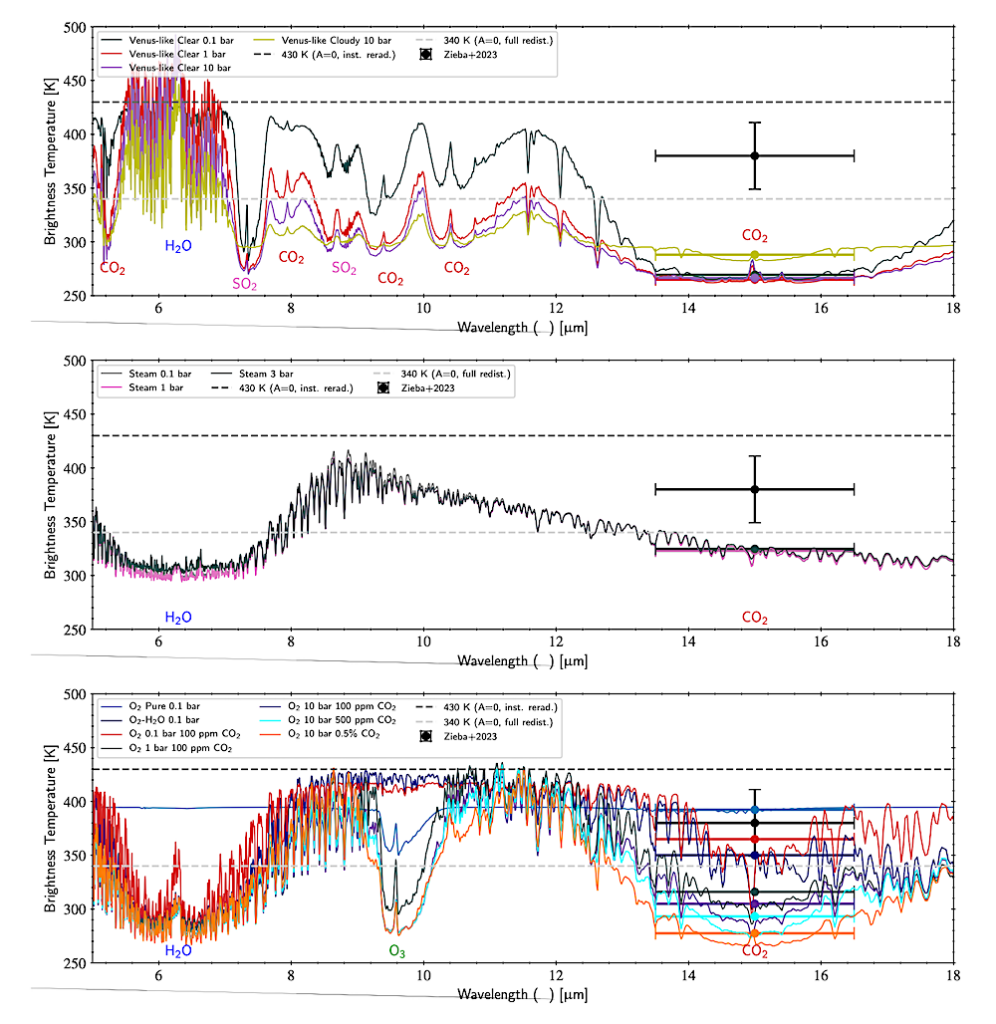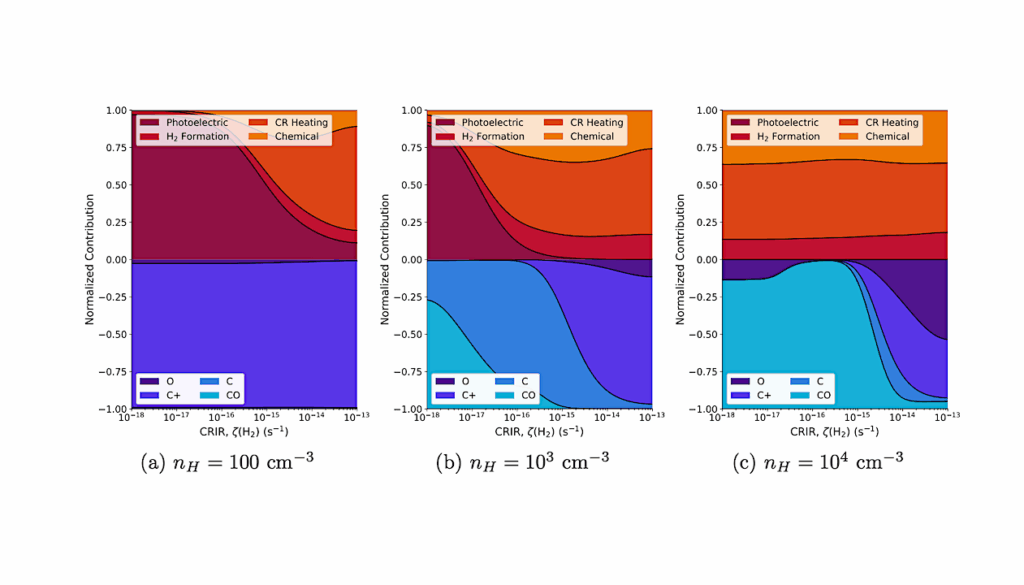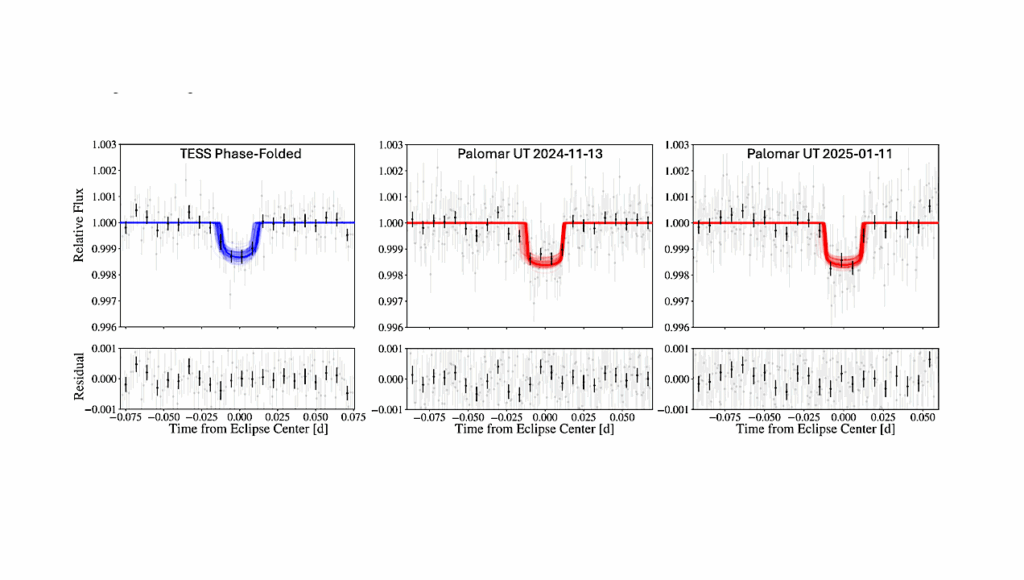Potential Atmospheric Compositions of TRAPPIST-1 c constrained by JWST/MIRI Observations At 15 μm

The first JWST observations of TRAPPIST-1 c showed a secondary eclipse depth of 421+/-94 ppm at 15 um, which is consistent with a bare rock surface or a thin, O2-dominated, low CO2 atmosphere (Zieba et al. 2023).
Here, we further explore potential atmospheres for TRAPPIST-1 c by comparing the observed secondary eclipse depth to synthetic spectra of a broader range of plausible environments. To self-consistently incorporate the impact of photochemistry and atmospheric composition on atmospheric thermal structure and predicted eclipse depth, we use a two-column climate model coupled to a photochemical model, and simulate O2-dominated, Venus-like, and steam atmospheres.
We find that a broader suite of plausible atmospheric compositions are also consistent with the data. For lower pressure atmospheres (0.1 bar), our O2-CO2 atmospheres produce eclipse depths within 1σ of the data, consistent with the modeling results of Zieba et al. (2023). However, for higher-pressure atmospheres, our models produce different temperature-pressure profiles and are less pessimistic, with 1-10 bar O2, 100 ppm CO2 models within 2.0-2.2σ of the measured secondary eclipse depth, and up to 0.5% CO2 within 2.9σ. Venus-like atmospheres are still unlikely.
For thin O2 atmospheres of 0.1 bar with a low abundance of CO2 (∼100 ppm), up to 10% water vapor can be present and still provide an eclipse depth within 1σ of the data. We compared the TRAPPIST-1 c data to modeled steam atmospheres of ≤ 3 bar, which are 1.7-1.8σ from the data and not conclusively ruled out. More data will be required to discriminate between possible atmospheres, or to more definitively support the bare rock hypothesis.

Brightness temperature spectra for the dayside hemisphere of all modeled environments, with points corresponding to the model spectra convolved to the F1500W filter band over the band’s wavelength extent (horizontal error bars show the FWHM of the filter band). We also plot lines for 340 K (blackbody, no atmosphere, full heat redistribution), and 430 K (blackbody, no atmosphere, no heat redistribution), along with the data point measured by Zieba et al. (2023), which has a brightness temperature equivalent to 380 ± 31 K. Top: Venus-like modeled environments. Middle: steam environments. Bottom: O2-dominated environments. The Venuses are between 2.6–3.1σ from the measured eclipse depth and the steam atmospheres are within 1.7–1.8σ of the measured eclipse depth. The clear-sky Venuses all exhibit similar CO2 bands between 0.1–10 bar. The steam environments spanning 0.1–3 bar are nearly identical across the MIR spectrum. The O2-dominated environments, with varying amounts of CO2, exhibit the largest range in their spectra, and those of ≥ 1 bar also exhibit strong ozone features. For reference, the F1500W brightness temperature values from Zieba et al. (2023) for their best-fit desiccated O2-CO2 atmosphere is 395 K, and their best-fit bare rock surface is 420 K. — astro-ph.EP
Andrew P. Lincowski, Victoria S. Meadows, Sebastian Zieba, Laura Kreidberg, Caroline Morley, Michaël Gillon, Franck Selsis, Eric Agol, Emeline Bolmont, Elsa Ducrot, Renyu Hu, Daniel D. B. Koll, Xintong Lyu, Avi Mandell, Gabrielle Suissa, Patrick Tamburo
Comments: 15 pages, accepted to APJL
Subjects: Earth and Planetary Astrophysics (astro-ph.EP)
Cite as: arXiv:2308.05899 [astro-ph.EP] (or arXiv:2308.05899v1 [astro-ph.EP] for this version)
Submission history
From: Andrew Lincowski
[v1] Fri, 11 Aug 2023 01:21:12 UTC (1,739 KB)
https://arxiv.org/abs/2308.05899
Astrobiology,








